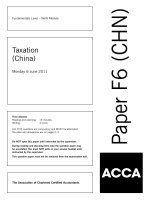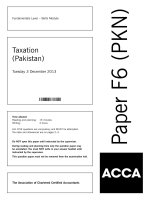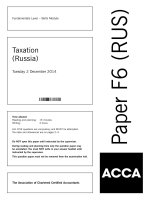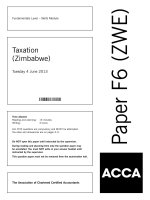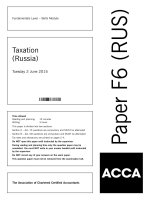ACCA f6 taxation romania 2014 dec question
Bạn đang xem bản rút gọn của tài liệu. Xem và tải ngay bản đầy đủ của tài liệu tại đây (256.06 KB, 12 trang )
Taxation
(Romania)
Tuesday 2 December 2014
Time allowed
Reading and planning:
Writing:
15 minutes
3 hours
ALL FIVE questions are compulsory and MUST be attempted.
Tax rates and allowances are on pages 2–5.
Do NOT open this paper until instructed by the supervisor.
During reading and planning time only the question paper may
be annotated. You must NOT write in your answer booklet until
instructed by the supervisor.
This question paper must not be removed from the examination hall.
The Association of Chartered Certified Accountants
Paper F6 (ROM)
Fundamentals Level – Skills Module
SUPPLEMENTARY INSTRUCTIONS
1.
2.
3.
Calculations and workings should be made to the nearest lei, unless instructed otherwise.
All apportionments should be made to the nearest month.
All workings should be shown.
TAX RATES AND ALLOWANCES
Personal income tax
General tax rate
16%
Income from employment
Benefits
Limit for non-taxable gifts
Limit for non-taxable voluntary pension contributions paid by the employer
Deductions
Deduction allowed for voluntary pension contributions paid by the employee
150 lei/person/occasion
€400/year
€400/year
Personal deduction
Number of dependent
persons for the taxpayer
Below 1,000
Monthly gross income (MI) – lei
Between 1,000 and 3,000
Above 3,000
0 persons
250
MI – 1, 000
250 x 1 –
2, 000
0
1 person
350
MI – 1, 000
350 x 1 –
2, 000
0
2 persons
450
MI – 1, 000
450 x 1 –
2, 000
0
3 persons
550
MI – 1, 000
550 x 1 –
2, 000
0
4 persons and more
650
MI – 1, 000
650 x 1 –
2, 000
0
Note: The value of the personal deduction resulting from the calculation should be rounded up to 10 (e.g. both 212
and 217 should be rounded to 220).
Income from the sale of immovable property owned by an individual
For immovable properties sold in less than three years from their acquisition
Income
Tax rate
Up to 200,000 lei
3%
Above 200,000 lei
6,000 lei + 2% of the amount exceeding 200,000 lei
For immovable properties sold in a timeframe longer than three years from their acquisition
Income
Tax rate
Up to 200,000 lei
2%
Above 200,000 lei
4,000 lei + 1% of the amount exceeding 200,000 lei
Income from renting
Lump-sum deductible expenses quota
25%
2
Copyright income
Lump-sum deductible expenses quota for:
– monumental works of art
– other
25%
20%
Self-employed income
The allowance accepted for public institutions’ employees
The limit of deductibility for protocol expenses
The limit of deductibility for compulsory subscription expenses
The limit of deductibility for subscription expenses
other than compulsory ones
The limit of deductibility for social expenses
Reference interest rate set by the Romanian National Bank for loans
denominated in lei
13 lei/day/person
2%
5%
2%
2%
4·25%
Investment income
Tax rate for capital gains from the sale of shares
Tax rate for interest received by individuals
Tax rate for dividends received by individuals
16%
16%
16%
Prize income
Tax rate for prize income
Non-taxable value
16%
600 lei/day/prize
Pension income
Non-taxable pension income
1,000 lei
Corporate income tax
General tax rate
16%
Minimum tax applicable to night clubs, discotheques, casinos or
sport betting activities
Reference interest rate set by the Romanian National Bank
for loans denominated in lei
Maximum accepted interest rate set by the Tax Code for loans
denominated in foreign currency
Inflation rate for prepayments of corporate income tax
The allowance accepted for public institutions’ employees
Maximum value of deductible expenses for employees:
– voluntary pension contributions
– private healthcare insurance contributions
Maximum value of deductible expenses for subscriptions to
non-profit organisations other than those which are compulsory or due
to the chambers of commerce and to employers’ organisations
The limit of deductibility for protocol expenses
The limit of deductibility for social expenses
Maximum value of tax credit for sponsorship expenses
3
5%
4·25% p.a.
6% p.a.
3·5% p.a.
13 lei/day/person
€400/tax year/employee
€250/tax year/employee
€4,000/year
2%
2%
20% of the corporate income tax but
not more than 3‰ of sales revenue
[P.T.O.
Corporate income tax for very small companies
Tax rate
3%
Straight-line depreciation periods (for tax and accounting purposes)
Class of asset
Buildings
Machines and equipment
Computers
Cars
Period in years
50
10
3
5
Note: The straight-line depreciation method for the above periods should be used in all cases, except where a question
specifically indicates another method and/or period is to be used.
The minimum value of an asset for tax depreciation purposes is 2,500 lei.
Tax on dividends paid to legal persons
For dividends paid to legal persons resident in Romania, EU or
EFTA countries
For dividends paid to other non-residents
16% or 0%
16%
Social security and other insurance contributions
Employed persons
Social security fund
Healthcare insurance fund
Unemployment fund
Work accident fund
Health insurance indemnities fund
Fund for guaranteeing salary payments
Self-employed persons
Social security fund
Healthcare insurance fund
Unemployment fund
Work accident fund
Health insurance indemnities fund
Persons obtaining rent income
Healthcare insurance fund
Employee
10·5%
5·5%
0·5%
–
–
–
Employer
20·8%
5·2%
0·5%
0·15%–0·85%*
0·85%
0·25%
31·3%
5·5%
1%
0·15%–0·85%*
0·85%
5·5%
Withholding rates for persons obtaining intellectual property revenues and revenues based on Civil Code contracts
Social security fund
10·5%
Healthcare insurance fund
5·5%
The average monthly earnings
The minimum monthly salary
2,223 lei
800 lei
* The exact value will be specified in the question, where necessary.
Note: These rates should be used in answering the questions, irrespective of the time period the question refers to.
4
Value added tax (VAT)
Standard rate
Reduced rates
Annual threshold for VAT registration
Annual threshold for a monthly tax period
Annual threshold for applying the cash accounting scheme for VAT
24%
9% and 5%
220,000 lei
€100,000
2,250,000 lei
Exchange rate
Euro/lei
€1 = 4·50 lei
Note: This rate should be used in all cases except where a question specifically indicates another rate is to be used.
Interest and penalties
Interest rate for late tax payments
Penalty level for late tax payments
0·04%/day
0·02%/day
5
[P.T.O.
ALL FIVE questions are compulsory and MUST be attempted
1
AppleTree SRL (AppleTree) is a company founded on 1 January 2013 based in Bucharest, which trades in jams and
jellies. AppleTree is owned by two shareholders: 60% by Adam SRL, a Romanian company, also based in Bucharest;
and 40% by Eve Co, a British company based in London, UK. AppleTree has a share capital of 20,000 lei.
For the year 2013, AppleTree recorded a net accounting profit of 450,000 lei and a taxable profit of 530,000 lei.
AppleTree allocated part of this profit to its legal reserve, within the limits required by the law. The remainder of the
profit was all distributed as dividends in March 2014. The dividends were paid to Adam SRL, and Eve Co, on
19 October 2014.
For the year 2014, AppleTree chose to apply the system of prepayments for paying corporate income tax. For the year
2014, AppleTree recorded an accounting profit of 1,200,000 lei before tax (expenses taken into account for this
accounting profit do not include the value of the prepayments of corporate income tax made during the year).
The following information relates to the revenues and expenses recorded by AppleTree in the year 2014:
(1) In 2013 AppleTree had paid a fine of 10,000 lei to the Romanian state and booked this fine as an expense in
that year. AppleTree appealed against this fine and in 2014, won the appeal and received a repayment of the
fine. This repayment was registered to revenue in 2014.
(2) On 25 December 2013, AppleTree bought a participation of 5% in the share capital of an Austrian company. In
March 2014, the Austrian company distributed and paid dividends for the year 2013. AppleTree received
25,000 lei as dividends from the Austrian company.
(3) On 20 June 2014, AppleTree bought and started using a company car for 86,400 lei, which will be straight-line
depreciated over four years for tax purposes and over six years for accounting purposes. The car is used
exclusively for business purposes and has five seats.
(4) On 30 June 2014, AppleTree took a loan from Eve Co of €200,000. The loan is to be repaid in full after three
years. The interest rate on the loan is 8% per year. On 31 December 2014, AppleTree registered the following
amounts in its accounts in respect of this loan:
–
–
the value of the interest expense due for the year 2014; and
exchange differences on the loan revaluation during the year on revenues of 13,000 lei and on expenses of
10,000 lei.
(5) Following an analysis of its account receivables, AppleTree decided on 31 December 2014 to book provisions
for the following bad debts:
Age of receivable
(days after maturity)
180 days
360 days
Value of receivable
Provision percentage
200,000
300,000
20%
40%
Neither of these receivables were guaranteed by a third person nor were they from affiliated persons or from
persons for whom bankruptcy procedure had been started. The entire value of receivables was included in
AppleTree’s taxable revenue.
(6) On 31 December 2013, AppleTree had assessed a receivable of 120,000 lei, which had been overdue for
300 days on 31 December 2013, as a bad debt and registered a provision of 60,000 lei. This receivable was
held by an individual, Mr X, was recorded to AppleTree’s taxable revenues in 2013 and was not guaranteed by
a third person. In March 2014 Mr X died, having no heirs and AppleTree cancelled the provision made in 2013
and registered the entire value of the receivable to losses.
(7) AppleTree also made in 2014 other provisions of: 50,000 lei for employees’ annual leave which had not been
taken as at 31 December 2014; and 100,000 lei for litigation.
(8) AppleTree has five employees. During the year 2014, AppleTree paid the following insurances for its employees:
voluntary pension insurance of 3,000 lei/year/employee; and life insurance of 1,000 lei/year/employee. None of
these insurances was taxed with employment income tax.
6
(9) On 20 November 2014, thieves broke into AppleTree’s warehouse and stole jams worth 10,000 lei and two
computers valued at 2,000 lei each. The value of all the stolen goods was registered to expenses. AppleTree’s
insurance only covered the loss of the computers and the entire amount of 4,000 lei received from the insurance
company was recorded to revenues in 2014.
Required:
(a) Identify ANY TWO categories of taxpayers subject to corporate income tax.
(2 marks)
(b) Compute the prepayments of corporate income tax due by AppleTree SRL for the year 2014 and state the
deadlines for paying and declaring these prepayments, clearly showing the amount to be paid at each
deadline.
(4 marks)
(c) Compute the tax on dividends, if any, which AppleTree SRL should have withheld from the dividends
distributed out of its 2013 profit if Eve Co has not provided AppleTree SRL with its fiscal residency certificate
for 2014. If no tax is due, state the reason.
Note: During 2013 AppleTree did not record any non-taxable revenues.
(4 marks)
(d) Compute the final corporate income tax liability of AppleTree SRL for the year 2014 and the amount due at
settlement, after taking account of prepayments.
Notes:
1. Include all the items referred to in notes (1) to (9) in your computation, indicating by the use of a zero
any item which has no impact on the computation of taxable profit.
2. As regards debt-to-equity ratio: for computing equity on 31 December 2014, use the accounting profit
before tax.
3. Ignore any value added tax (VAT) implications.
4. Ignore any tax implications in Austria of the dividends received from the Austrian company.
(20 marks)
(30 marks)
7
[P.T.O.
2
Mr Lemon is a German citizen, with his domicile in Hamburg, who works for German GmbH, a company resident in
Germany. German GmbH owns 80% of Rogerman SRL, a company resident in Romania. The other 20% of
Rogerman SRL is owned equally (10% each) by Mr Lemon and Miss Orange, a Romanian resident. In April 2014,
Rogerman SRL distributed gross dividends with a total value of 100,000 lei.
In January 2014, Mr Lemon was seconded to Rogerman SRL in Bucharest for five months. Mr Lemon continued to
receive his salary from his German employer during his secondment. Mr Lemon’s gross monthly salary is €3,000.
Employee’s social contributions of €600 per month, in relation to this salary, were paid in Romania. At the end of
the initial five months, German GmbH extended Mr Lemon’s secondment for a further five months on the same
financial terms.
On 30 October 2014, Mr Lemon returned to Germany at the end of his secondment, but on 18 December 2014, he
will return to Romania to marry Miss Orange. After their marriage, on 1 January 2015, Mr Lemon and Miss Orange
will move to Mauritius and in 2015 both change their tax residence to Mauritius. Romania does not have a double
tax treaty with Mauritius.
Miss Orange is employed by Rogerman SRL as an IT consultant. In addition to her gross monthly salary of 4,500 lei,
Miss Orange received the following benefits in kind throughout 2014:
(1) Use of a company car. The company car has an accounting value of 75,000 lei and is used by Miss Orange
70% for business purposes and 30% for personal purposes.
(2) Ten meal tickets of 9·35 lei/ticket every month. Miss Orange worked for at least 13 working days each month in
2014.
(3) Miss Orange made a three-day business trip within Romania every month, for which she received a gross per
diem allowance of 60 lei/day.
(4) Rent compensation of 500 lei/month. There was no legal obligation for Rogerman SRL to cover Miss Orange’s
rent.
(5) Miss Orange bought discounted products each month as offered by Rogerman SRL during its monthly discounted
sales week. The value of the discount obtained each month by Miss Orange is 200 lei. The same discount is
applicable to all of Rogerman SRL’s customers.
(6) Private health insurance of 100 lei/month.
Miss Orange also has a self-employed activity in the field of IT consultancy, which is taxed according to income
quotas. For 2014 the annual income quota applicable to Miss Orange is 140,000 lei.
On 31 December 2014, Miss Orange will quit her job with Rogerman SRL and end her self-employed activity in
Romania.
8
Required:
(a) List the conditions used to determine whether an individual will be considered a fiscal resident in Romania
and state, giving reasons, whether Mr Lemon will be considered a Romanian resident for tax purpose in
2014.
Note: Ignore any double tax treaty provisions which may be applicable.
(3 marks)
(b) Determine the income tax due in Romania by Mr Lemon in 2014 for the revenues he receives, stating who
has the obligation to pay and declare the tax.
Note: Ignore any double tax treaty provisions which may be applicable.
(5 marks)
(c) Determine the income tax due in Romania by Miss Orange in 2014 for the revenues she receives, stating
who has the obligation to pay and declare the tax.
Notes:
1. Include all the items referred to in notes (1) to (6) in your computation, indicating by the use of zero any
item which has no impact on the computation of income tax.
2. Miss Orange is not entitled to the income tax exemption applicable to IT employment income.
(12 marks)
(d) Explain how Miss Orange will be taxed by the Romanian state in 2015 and subsequent years, following her
change of tax residence to Mauritius.
(2 marks)
(e) State one example of individuals’ revenue for which:
(i) the tax paid during the year is the final tax;
(ii) the tax paid during the year represents a prepayment of tax only; and
(iii) the taxpayer may opt for either a final tax or a prepayment of tax basis.
In the case of each example, identify the person liable for declaring and paying the tax.
(3 marks)
(25 marks)
9
[P.T.O.
3
(a) Explain what is meant by an intra-community supply of goods and state the rules for determining the place
of such a supply.
(2 marks)
(b) Explain what is meant by an intra-community acquisition of goods and state the rules for determining the
(3 marks)
place of such an acquisition.
(c) The Association for the Protection of the Environment (ASPE) is established in Romania, is a non-taxable legal
person for value added tax (VAT) purposes and is not currently registered for VAT.
ASPE bought two items of equipment for purifying water. After purchase, the equipment was donated to two
municipalities in Romania. Both items of equipment were bought from a person established and registered for
VAT in the Netherlands and were transported upon purchase from the Netherlands to Romania.
ASPE bought the first item of equipment in March 2014 for €8,000 and the second item of equipment in June
2014 for €9,000.
Required:
Explain the VAT treatment of each of the acquisitions of equipment and state APSE’s VAT obligations in
Romania, if any.
(5 marks)
(d) State the general rule for the determination of the place of supply of services when the services are provided
to (i) taxable persons; and (ii) non-taxable persons.
(2 marks)
(e) Oak SPRL is a partnership providing legal services, which is registered for value added tax (VAT) in Romania. In
March 2014, Oak SPRL provided the following services (all amounts are stated exclusive of VAT):
(1) Revised a trade contract for Afla Co, a company established and registered for VAT in the UK, for 5,000 lei.
(2) Acted as legal representative for Mr Peanut, a Romanian citizen living in Romania, for 2,000 lei.
(3) Drafted documents for the sale of an apartment in Bucharest to Beta Ltd, a company established and
registered for VAT in the UK, for 3,000 lei. The apartment was sold on 31 March 2014.
(4) Revised a trade contract for Gama SRL, a company established and registered for VAT in Romania, for
4,000 lei.
Required:
Calculate the value added tax (VAT) which Oak SPRL should have charged, if any, on each of the transactions
(1) to (4). If Oak SPRL does not have an obligation to charge VAT, state the reason why.
(3 marks)
(15 marks)
10
4
Pine SRL is a company which was established in Romania in 2011 and registered as a corporate income tax payer
and a value added tax (VAT) payer.
At the end of 2011, Pine SRL recorded a tax loss of 10,000 lei. During 2012 and 2013, Pine SRL applied the special
scheme of corporate income tax for very small companies but, from the start of 2014, Pine SRL again applied the
standard corporate income tax regime.
On 12 December 2011, Pine SRL bought equipment for 250,000 lei which it has depreciated – over six years using
the accelerated depreciation for tax purposes and over five years using the straight-line depreciation for accounting
purposes.
The actual and estimated turnover and accounting profit of Pine SRL during the years 2012 to 2015 is:
Year
Turnover
Accounting profit
2012
lei
150,000
70,000
2013
lei
120,000
20,000
2014
lei
200,000
8,000
2015
lei
850,000
450,000
Pine SRL’s only source of revenue is from its turnover.
Required:
(a) State the rules for the carry forward of tax losses and explain how Pine SRL can recover its loss of 2011,
clearly identifying the years in which this tax loss may be recovered.
(4 marks)
(b) For each of the years 2012 to 2015, compute the corporate income tax due to the state by Pine SRL.
(7 marks)
(c) Explain the self-assessment system and the tax return filling procedures for corporate income tax.
(4 marks)
(15 marks)
11
[P.T.O.
5
(a) Strawberry-Blueberry SPRL (SB) is a partnership established in January 2014 between two lawyers –
Mr Strawberry, with a participation of 60%; and Mr Blueberry, with a participation of 40%.
For 2014, SB estimated its net annual income as 200,000 lei. However, the realised net income for the year
2014 was 320,000 lei.
Required:
(i)
State the declarations which should have been filed for income tax purposes by SB and its partners for
2014 and identify the deadlines for filing each of these declarations.
(3 marks)
(ii) Compute the prepayments of income tax, the final tax liability and the balance due by Mr Strawberry
for his 2014 revenues, stating the deadlines for making each of these payments.
Note: Ignore any social contributions which may apply.
(5 marks)
(b) In 2014 Raspberry SRL, a Romanian limited liability company, had only one employee, Mr Con, who was paid
a gross salary of 2,000 lei/month. Mr Con was employed by Raspberry SRL during the entire 2014 and his gross
payment was 2,000 lei/month in each month of 2014. Starting from 1 January 2015, Raspberry SRL will cease
Mr Con’s employment agreement but continue to work with Mr Con, under the same conditions as when he was
an employee, but pay him based on a civil contract, also for 2,000 lei/month. Under both agreements, Raspberry
SRL will pay all taxes and social security contributions due according to the type of contract signed with Mr Con,
without making any reclassification according to the economic activity actually performed.
Mr Con has never had any job except with Raspberry SRL and he does not have any person under his care.
Required:
Compute the annual total expenses incurred by Raspberry SRL in respect of Mr Con in each of the years
2014 and 2015.
Note: The work accident fund contribution rate is 0·15%.
(5 marks)
(c) Explain the difference between tax avoidance and tax evasion.
(2 marks)
(15 marks)
End of Question Paper
12
